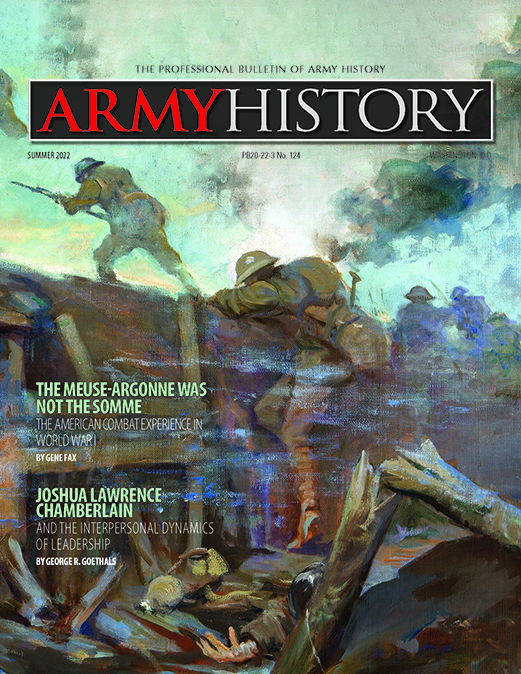Passion for Military History

Since 2012, Bryan Hockensmith (Wright State University, 2003) has served as managing editor of Army History. Initially founded in the fall of 1983 as The Army Historian, the publication has enjoyed a long and distinguished tenure as the U.S. Army’s premier professional history bulletin.
Hockensmith first put his bachelor’s degree in history to work in a contracting job as a military collections analyst at the U.S. Army Center of Military History (CMH) in Washington, D.C. In 2007 he got a government position at CMH as the distribution editor for all CMH publications—there are more than 600 titles. He completed a master’s degree in military history from Norwich University in Vermont in 2008. That same year he also took on the duties of book review editor for Army History magazine. In late 2011 the previous managing editor retired, and Hockensmith took over the role.
Hockensmith said the issue he is most proud of is his first issue as managing editor (Winter 2012, No. 82) or the issue for which he was the guest managing editor (Winter 2009, No. 70) while the current managing editor was away on medical leave. “Being asked to be the guest managing editor showed that my supervisors had confidence in me, and completing the issue successfully proved that I could actually do the job and do it well,” he said.
Hockensmith is passionate about his work. “I love military history! So, this is really a dream job as I’m surrounded by it every day. I get to work on so many interesting topics, and seeing a rough draft of an article come together and come to life in the pages of the magazine is very rewarding. I also work with a great group of coworkers. Army History is really a team effort, and I couldn’t do it without their help,” Hockensmith said.
While he doesn’t find much free time, he does enjoy reading the Journal of Military History, a publication of the Society for Military History (SMH). He recently joined SMH’s Vandervort Prizes Committee, which selects the best articles in military history published each year.
He served in the Ohio Army National Guard from 1997 to 2003 in the 1st Battalion, 134th Field Artillery. For most of that time, he was the battalion public affairs representative.
Hockensmith values his experience as a member of Delta Tau Delta, staying in touch with brothers online and through a recent reunion with two brothers. “The Delt values certainly helped guide me through my early career and continue to light my path. I often refer to them when I have difficult decisions to make,” Hockensmith said.
This year Hockensmith guides Army History through its 40th year.
Army History at 40

By Bryan J. Hockensmith (Wright State University, 2003)
Army History, founded in the fall of 1983 as The Army Historian, has enjoyed a long and distinguished tenure as the U.S. Army’s premier professional history bulletin. The first issue was a bold statement of intent and proposed a new direction for the Army’s historical community. Secretary of the Army John O. Marsh Jr. graced the cover and offered these words, “I am honored to introduce The Army Historian, a periodical dedicated to the proposition that an appreciation of military history is a valuable addition to an officer’s intellectual background . . . this publication will help us have a better understanding of the value of history. But, in addition, by careful explanation and provocative example, it should attract the attention of those thus far uninitiated in the uses of this valuable discipline.” Marsh commenced immediately to use The Army Historian as a conduit to announce and enact reform within the Army history program.
The chief of military history at the time, retired Brig. Gen. Douglas Kinnard, noted that Secretary Marsh had “asked for a change in priorities among [the Center of Military History’s] missions in order to develop more effective means of supporting the Army through the remainder of the century.” Marsh called for “increased support of the Army staff in their planning; support of military history education in the Army; and establishment of a National Museum of the United States Army.”
These were certainly lofty goals and noble tasks, and over the years The Army Historian—renamed Army History in 1989—did what it could to contribute to this mission. It would take time for this periodical to grow and become an established publication that the Army respected and that had the impact so desired by Secretary Marsh. From the late 1980s and throughout the 1990s, The Army Historian/Army History cemented itself as the Army’s preeminent professional bulletin. Army History’s reach increased as its readership grew, and its high level of scholarship became recognized more widely. A number of talented editors shepherded the journal through its formative years, securing an ever-increasing number of qualified contributors and implementing layout and design changes to make the journal’s pages more attractive. In a 40-year span, Army History has evolved from a black-and-white “newsletter” with a few hundred readers to a full-color magazine with a print run of 10,000 copies and a hard-copy and online readership numbering in the tens of thousands. During these years, Army History published articles from a Secretary of the Army, John O. Marsh Jr.; two chiefs of staff of the Army, Generals John A. Wickham Jr. and Carl E. Vuono; and a profusion of notable historians and authors, including Jay Luvass, Alfred Goldberg, Theodore Wilson, Edward Coffman, Ronald Spector, Antulio Echevarria, Gregory J. W. Urwin, Victor Davis Hanson, Wayne Lee, Jon Sumida, Charles Neimeyer, Richard Faulkner, William Hammond, Dennis Showalter, and George Herring, to name a few. Over the years Army History has received multiple awards for its content from organizations such as the Society for Military History, the Army Historical Foundation, and the Society for History in the Federal Government.
Army History’s role in supporting military history education cannot be understated. The Army War College, the National Defense University, the Command and General Staff College, the U.S. Military Academy, and Army branch schools and museums all use it in their curriculums, and Reserve Officer Training Corps students receive issues. Copies even find their way to, and requests for subscriptions come from, places such as the Air Force and Naval academies and various government agencies, as well as foreign military service institutions.
In 2008, public demand for access to hard copies of Army History prompted the U.S. Government Publishing Office to begin selling yearly subscriptions. In that same year, we completed a digitization project that made every back issue available online as a free PDF download.
In my years as the managing editor (2012 to present) and steward of this publication, I have done my best to maintain the high scholastic standards of Army History while broadening its appeal, improving its aesthetics, and increasing its audience. The results from a recent online Army survey indicate that the publication is on the right track and that efforts have been very successful thus far.
I would be remiss if I did not thank the team of editors, visual information specialists, and cartographers who set their regular workloads aside to assist me with each new issue. Army History would not be possible without their efforts.
I am very proud of what Army History has become, and I am even more excited about where it can still go in the years ahead. I hope you enjoy reading Army History articles as much as I love publishing them.
Bryan J. Hockensmith, Managing Editor
NOTES
1 John O. Marsh Jr. “This Enterprise Serves a Worthy Purpose. I Wish It Well,” The Army Historian, no. 1 (Fall 1983): 1.
2 Douglas Kinnard, “Secretary Marsh Sets New Directions for Army Historians,” The Army Historian, no. 1 (Fall 1983): 3, 12.
